Hello,
Welcome to today’s edition of Kitchen Projects. Thank you so much for being here.
Today, it’s all about my *favourite ever dessert*: The squidgy delight that is Pão de Ló. It’s a relatively simple recipe that reaps MAJOR rewards.
Over on KP+, I’ll be sharing the chocolate version of the Pão de Ló and I’m also doing a giveaway of nata tins! I picked up a bunch of proper ones when I was in Lisbon and I’ll be selecting subscribers at random to receive 10x of your own to make your nata dreams come true (woooo hoooo!). All you have to do to enter is be subscribed to KP+ and I’ll pick names at random next week:
Love,
Nicola
PS. Due to the pop-up, there will be no Sunday newsletter next week. KP+ content will be unaffected
Pie Party!
Before we get started on today’s KP, I want to let you know all about next weekend’s PIE PARTY POP-UP!
When I’m not writing Kitchen Projects and doing development, I love to dream up fun food events for my pop-up bakery Lark! and figure out ways I can collaborate with some of my favourite chefs. Next week, I have the absolute pleasure of cooking with one of the best: Verena Lochmuller.
Verena is the head of pastry development at OTK: Ottolenghi Test Kitchen. She was my head chef when I was working at Ottolenghi and we’ve always bonded over our love of desserts, including pie. Verena is an absolute pie don and I’m thrilled to be doing this pop-up with her - she’s a huge inspiration and mentor to me! The menu will include the apple-iest apple pie, a perfectly sharp lemon meringue pie, caramel & vanilla pear pie, plum damson & blackberry crumble pie and a chocolate malt coffee dream cream pie. We’ll also be serving up scoops of La Grotta Ices AND Nonnas Gelato.
The pop up is next Saturday from 10AM until sold out. Hope to see you for a slice there. Yes, this is officially permission for you to eat pie for breakfast.
Lisbon tips!
First off let me tell you: KP is not becoming a travel blog. PROMISE. But after my trip to Lisbon, a lot of people asked me to share my faves/hot tips so we’ll quickly do that now.
One of the beautiful things about the internet/instagram (for all its darkness) is the relative ease that you can reach out to share information, favourite spots, favourite dishes and tips for travelling. I was fortunate enough to be given tons of recommendations for Lisbon and I’m excited to share them today. Obviously there were too many for me to try out but I’ve included everything I was recommended so you can create your own perfect trip:
Here it is in map form
Here it is in spreadsheet form w/ more details, number o times it was recommended and if I’ve been there (if that’s your kinda thing)
Pão de Ló-ve of my life
I don’t say this lightly but this might actually be my favourite dessert in the world. This is my go-to dinner party dessert. I’ve carried it across London in its tin a number of times and it’s always greeted with gleeful squeals. Although I’ve been meaning to cover Pão de Ló on here, my recent trip to Lisbon reminded me of the utter joy it brings me.
Described on the internet as a ‘fallen souffle cake’ or a ‘gooey egg cake’ among other things, the Pão de Ló is an ultra soft, chewy and light sponge cake that is baked HOT and short to achieve two textures. It is perhaps an unconventional cake but my GOD, it is good. It has basque cheesecake energy in that you bake it high, it souffles up then falls as it cools, plus you line the tins in the same way (“rustic”).
Food journeys of Portugal
I’ve mentioned this a few times in past KPs, but Portugal has played a particularly prominent role in exporting food trends and cultures past its own borders and collecting new ones on its way.. Most famously, the arrival of Portguese traders and missionaries in the 16th century was also the arrival of food customs still enjoyed today, now known as ‘nanban’. Nanban is an old term that translates as ‘Southern barbarian’ and, thanks to the Portugese tastes, Nanban cuisine had a lot more oil, sugar and spices than the regular Japanese cuisine at the time. Nanban cuisine includes dishes like Tempura and Castella cake, the latter coming from today’s subject. As well as this, we can thank the nuns for using egg whites to starch their clothes, leaving lots of leftover yolks resulting in many delicious yolk based desserts.
ASIDE: I cannot find any practical information ANYWHERE about how egg whites were *actually* used to starch clothes. I know this is possibly beside the point of KP, but I have no idea and am desperate to know. This fact is everywhere but I’m fascinated how this could possibly be effective. Any thoughts, please message me.
Much to my chagrin, I still can’t really pronounce ‘Pão de Ló’ properly. Despite a number of cry-for-help response voice notes in my DMs and in-person lessons at bakeries and stalls in Portugal, it evades me. Portuguese is a hard language to wrap your tongue around, with its - apparently - excruciating verb conjugation, unique ‘ã’ vowel sounds and (according to one of my Uber drivers last week) the tendency of locals to just ‘drop the beginning and end of words randomly’(!). But what I lack in linguistic skills, I make up for in enthusiasm for Portuguese cuisine.
I first tried Pão de Ló at Nuno Mendes’ now-closed Taberna da Mercado in Spitalfields in December 2017. At the end of our meal, we were presented with a Pão de Ló and two spoons. Whether it was the juicy, oily, tender cake itself or whether it was the heady combination of working night shifts, falling in love and being well over half a bottle of wine into dinner, I was enamoured. Plus looking back on a pre-pandemic world, is there anything more romantic and naive than a shared dessert with many carefree double-dipped spoons?!
The next time was in Portugal, a slice by a company actually called ‘o melhor pão de ló do universo’ aka ‘the best pão de ló in the universe’.
BTW, Pão de Ló literally means sponge cake, btw, so if you’re looking for the gooey kind you’re best off looking for the Alfeizerão style, which is known for the gooey or ‘underbaked’ middle.
Egg foams and how to nail them (refresher course)
If you’ve been reading KP for a while, you know I’m pretty obsessed with egg foams. Like, if a recipe has egg foams in, then I’m all in. Thanks to Chef Ayako and my *many hours of testing* for the genoise sponge back in May, I’m happy to say that my egg foams have been stronger than ever. So where does this cake sit on the spectrum of previous KP egg foam cakes?
Compared to chiffon and genoise, Pão de Ló has a higher proportion of yolks and whole eggs overall. Its sugar content is within the same range but it has a much lower % flour. The oil % is on the same level as the butter in the genoise, but acts differently - yes, it enriches, but the liquid fat adds a characteristic that butter can’t achieve. You go olive oil!
In the strawberry shortcake KP, we discovered that to achieve the perfect genoise you need to whip your eggs on three speeds to achieve proper ribbon stage: HIGH to get the maximum air bubbles into the developing egg protein/sugar network, then MEDIUM to split the large, unstable bubbles into a finer foam then finally only SLOW, which smooths out the egg foam into a super shiny, stable, ribbon stage.
For the Pão de Ló, this super fine stable foam isn’t as important as the final product is going to be jammy/undercooked. So, for the mixing for this cake, I still use the three stage mixing process but I reduce the times significantly.
Boxed vs. Fresh Yolks
This recipe lives and dies on the quality of eggs you use. Because we are going for that bright yellow sponge and undercooked centre, you do want to use top, freshest eggs. I have always had great results from St Ewes and Clarence Court Burford Browns.
Although boxed yolks aren’t really on the market for regular consumers and are reserved for commercial kitchens only (at the moment), I’m endlessly fascinated at the performance of a fresh yolk vs. a boxed, pasteurised one.
I put it to the test: Here’s three Pão de Ló’s made with the same recipe but one with *cheaper* boxed yolks, one with more expensive boxed yolks and one with fresh, separated fresh yolks. From above, they look exactly the same… but inside? It’s a whole different story:
I was SHOCKED at how different the three were. On the left, the cheap boxed yolks gave a frothy, totally unset texture. In the middle, the more expensive boxed yolks had a better colour and also set more firmly. On the right, the fresh separated yolks gave a jammier, fudgier and bright colour. If there’s anyone reading this that is a total pro on pasteurisation… drop me a line! Super keen to understand this further.
Yolk %
You know, we all hate having extra egg whites laying around. Although there are lots of good things we can do with them (hi brownies? Hi creme caramel?), I resent separating eggs! But it is essential in this case. The yolk gives the cake a jamminess that can’t be replicated with whole eggs. I tried a version with whole eggs, more along the line of a genoise, and the cakes were missing a dense-ness of texture. So, separating yolks it is. But how much?
I tested both 1:1 and 1:1.5 whites to yolks, and on a less baked cake (i.e. very oozy), there was little to no difference in the flavour. However, for a slightly more set bake, the jamminess of the yolks really paid off as the batter thickened as it cooled. The versions with a higher percentage of whites stayed oozy, but the liquid was very bubbly and a bit thinner - less unctuous. So, although you’ll have a few leftover whites, I promise it’s worth it. We’ll do something with them soon.
Adding olive oil
The original Pão de Ló doesn’t have olive oil in it, but Nuno Mendes added it to his and I can’t possibly enjoy it any other way now! Especially if you use a fruity one. Thank you Nuno.
The olive oil does two things here - much like in a chiffon cake, oil adds flexibility and moisture which gives your crumb that ‘tearing’ and cotton-y effect. But mainly we want to add flavour. As well as putting it inside the cake, this dessert is best enjoyed with a generous drizzle of olive oil on top just before serving.
Baking time / the Level of Goo
Ok, so out of all the times I’ve served this cake, I’ve only once been asked ‘err, this is just like… raw cake batter’ and the answer is…. Kind of?
In reality, if you do temp it - it does cross into the high temp safe zone, so it isn’t RAW - it’s more ‘unset’ for a lack of a better word. But this is want you want: That eggy, olive oily cake goo is really magical - like a sort of self saucing pudding - your dessert comes with its own dip…. made of itself. So even though I ADORE the goo, I understand how it might not sound that appealing. The key to baking the Pao de Lo is baking it hot/long enough for a smooth shiny crust to form (thank you eggs! Thank you sugar!) but only “just” long enough that the centre doesn’t set too much.
On the extreme side, like the ‘best cake in the universe’, the goo or ‘egg cream’ is totally liquid and expansive, ending up in a puddle at room temperature. For both the rectangle and round shape, I tested a variety of baking temperatures and times. For the round mould, the surface area lends itself to a short but very hot bake so a crust can form. To get a similar result on the rectangle, it needs to be at a lower temperature due to the increased surface area, though the baking time stays similar.
My preferred texture is a little goo but mainly soft cake. And if you are new to Pão de Ló, I think it’s best to err on the more set side of goo. I think you’ll be making this recipe a lot, so you can always cut the bake time later if you decide you love the middle bit.
Goo vs. Freezer
I have been wracking my brains to understand how the ‘o melhor pão de ló do universo’ managed to keep *this insane* level of goo and, after lots of tests, I’m pretty sure the answer is two fold: 1) large pan / surface area and 2) the freezer.
Let’s start with the latter: Once the cake is cooked around the edges, I think these cakes are cooled and then transferred into deep freezers. On serving, the cake is defrosted at room temperature and the goo is revealed! This way, carry over cooking is stopped completely in its tracks and the rest of the cake doesn’t reabsorb the moisture, giving you a defined layer.
As for the pan size, the larger the surface area, the better contrast of textures you’ll get - similar to the basque cheesecake. The smaller you go (aka, the more home baking friendly!) often the harder it is to achieve those dramatic textures.
Shelf life
These cakes keep surprisingly well. Although you can definitely enjoy them on the day you make them, you can hold these for up to two days without losing much quality. On day 3, the cake begins to breakdown and it becomes a bit eggy (ugh, my worst word)
Tin situation
A few years ago during a particularly passionate Pão de Ló phase, I purchased these special tall 6inch aluminum tins - they’re super deep and useful for all sort of bakes, but they are the perfect tin for Pão de Ló.
Fortunately you can also use any baking dish you want - the tall paper collar will help turn any tin into a Pão de Ló tin. If you want to make a small Pão de Ló but don’t have a small round tin, you can use any small baking dish. I did tests in a falcon enamel tin, 5 inch x 7 inch, which I was really happy with the results. However you do need to bake at a lower temperature to get the texture definition (details on that below).
Adapting the recipe
As well as the chocolate version on KP+, you can totally adapt this recipe to suit your tastes. From adding honey in with the olive oil, or rose water, or orange blossom, you can adapt this recipe to suit your tastes! Coffee powder, matcha or malt powder would also be fantastic. As well as this, scoops of nutella, pistachio paste or any sort of fatty spread would also incorporate beautifully - I’d start with a tablespoon and go up from there and combine it during the oil mixing in phase as not to deflate the foam too much during folding.
The recipe
This recipe marks the trifecta of Portugese inspired Kitchen Projects, here’s a link to the other two:
Makes 1 x 6 inch cake, good for two to share
80g yolks (about four)
60g whites (about two)
55g caster sugar
30g olive oil
30g plain flour
1g salt
To serve: To make it more of a traditional dessert, you can serve with whipped cream and berries/fruit OR simply extra olive oil
Pre-heat oven to 210c fan (for 6 inch round tin) or 180c for the rectangular tin
Line 1 x 6 inch tin with paper - you want about 5-10 cm above the tin and you can trim it once the batter is in (in case its taller than you think!)
Whisk white and yolks with sugar at high speed for 5 minutes, then medium speed for 3 minutes, followed by low speed for 5-10 minutes. This will give you the silkiest and most stable egg foam and will contribute to the texture and rise of your cake
Meanwhile, measure out your flour (sifted) and olive oil in separate bowls
To mix in the oil, take around two tablespoons of the egg foam and whisk together until homogenous. Fold together
Finally, fold through the flour and salt using the ‘D’ motion. If you have trouble with your egg foams deflating, it’s sensible to pour this into a larger bowl so you have more space to fold!
Pour into your tin and bake. You can trim the paper up at this stage if it seems excessive:
6inch round at 210c
10 minutes for a gooey centre sponge
11 minutes for a less gooey/firmer sponge
12 minutes for an even more firmly set sponge
For a REALLY gooey cake, bake at 220c fan for 8 mins
5inch x 7inch Rectangle tin at 180c
10 mins for gooey
12 mins for *just* gooey
15 mins for well cooked, only slightly jammy
I think Pão de Ló is best around 1 hour after baking if warm but it is fabulous after a night or two in the fridge. You can make this up to two days in advance
This is fantastic with berries and whipped cream, but wonderful on its own with an extra drizzle of olive oil

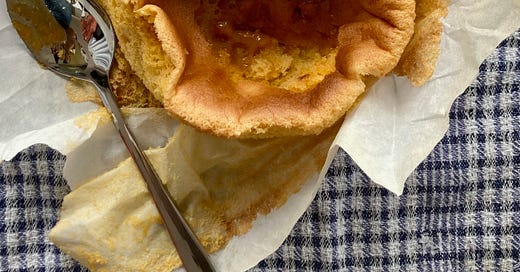


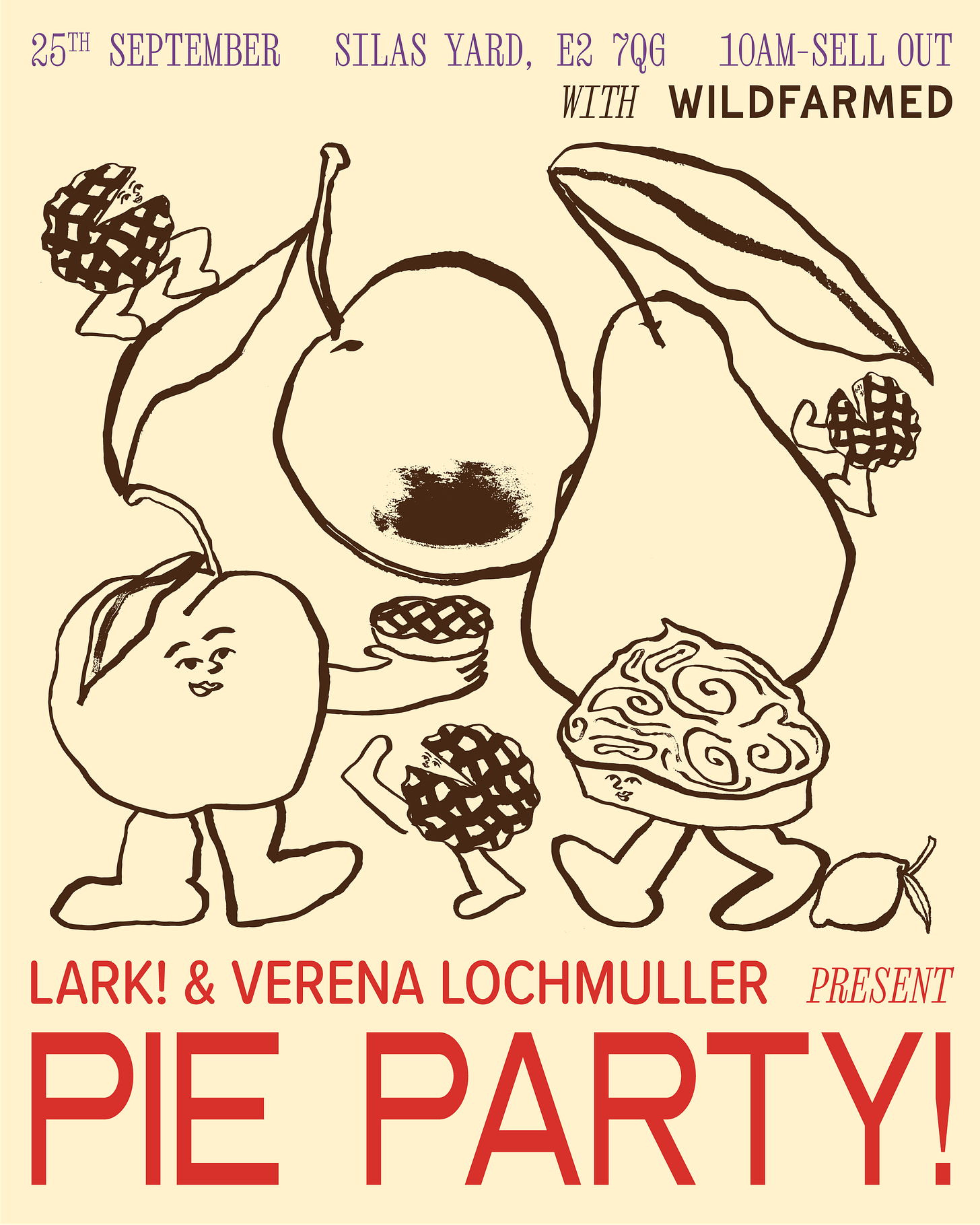
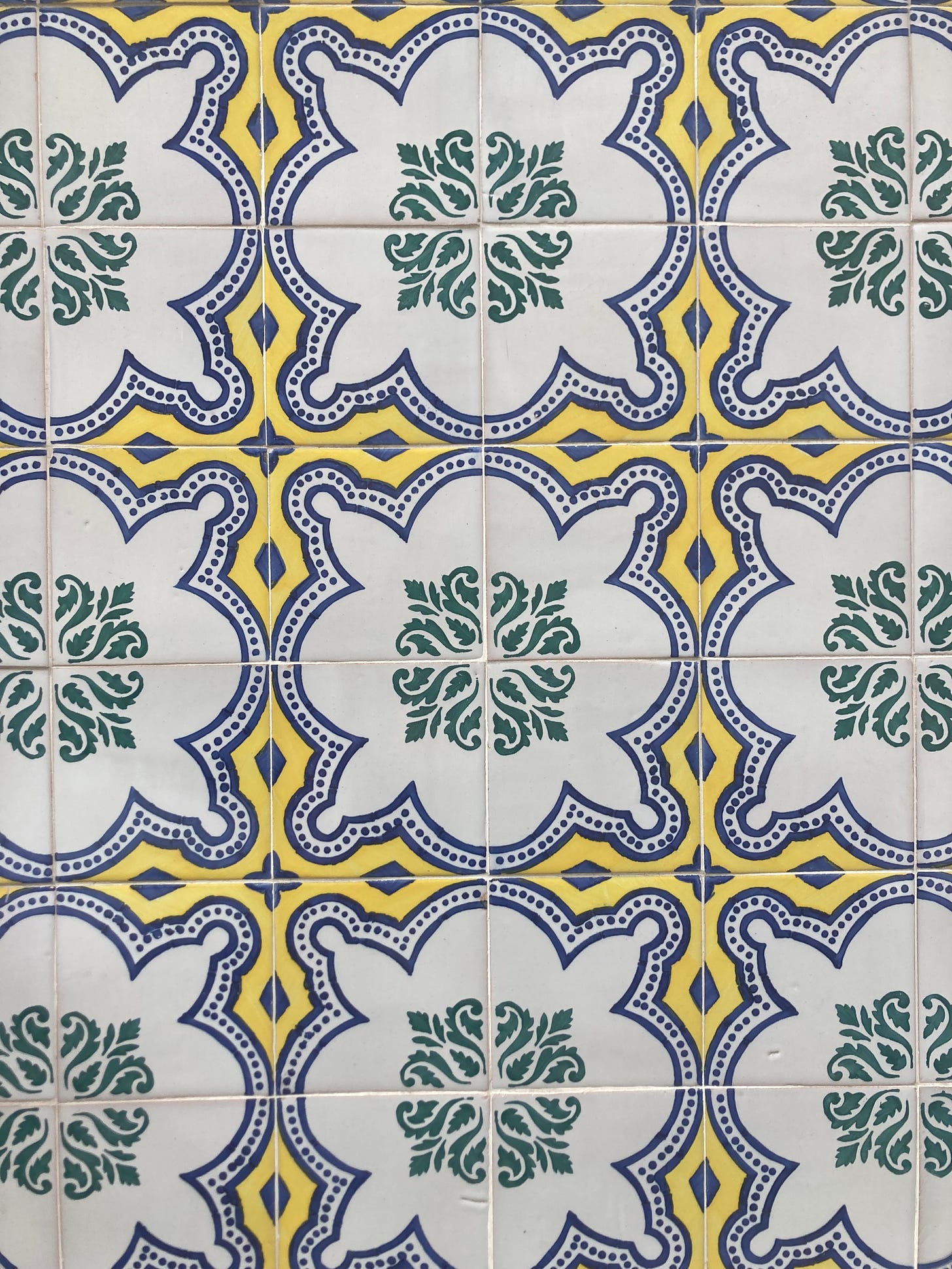
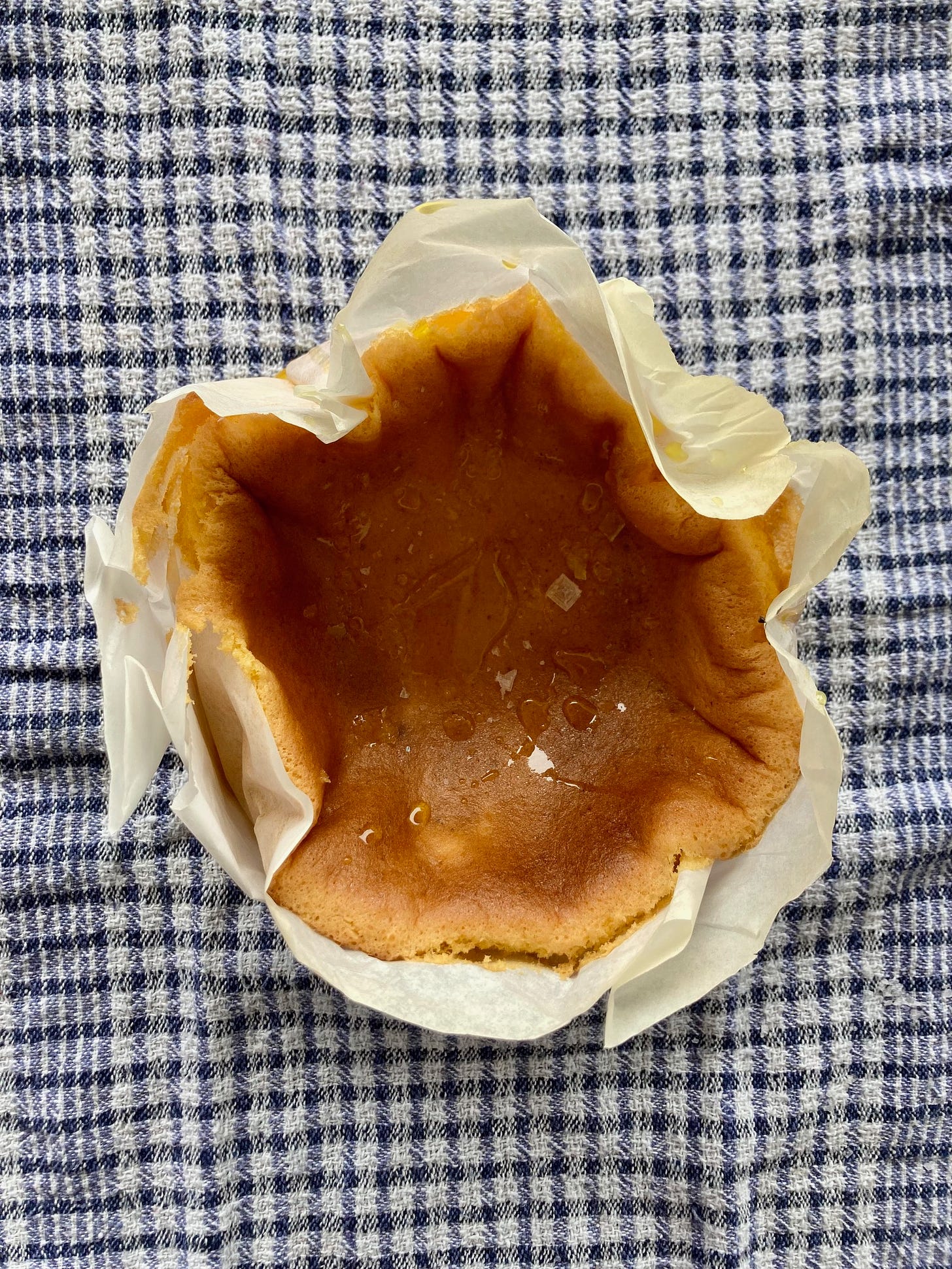


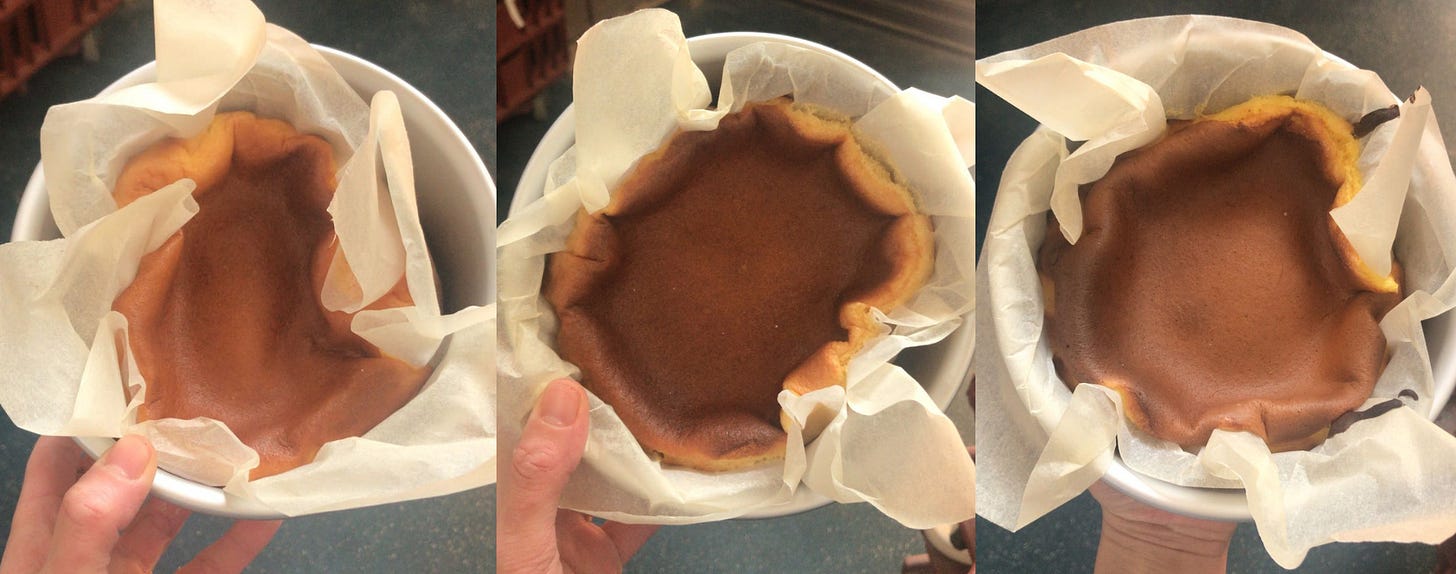
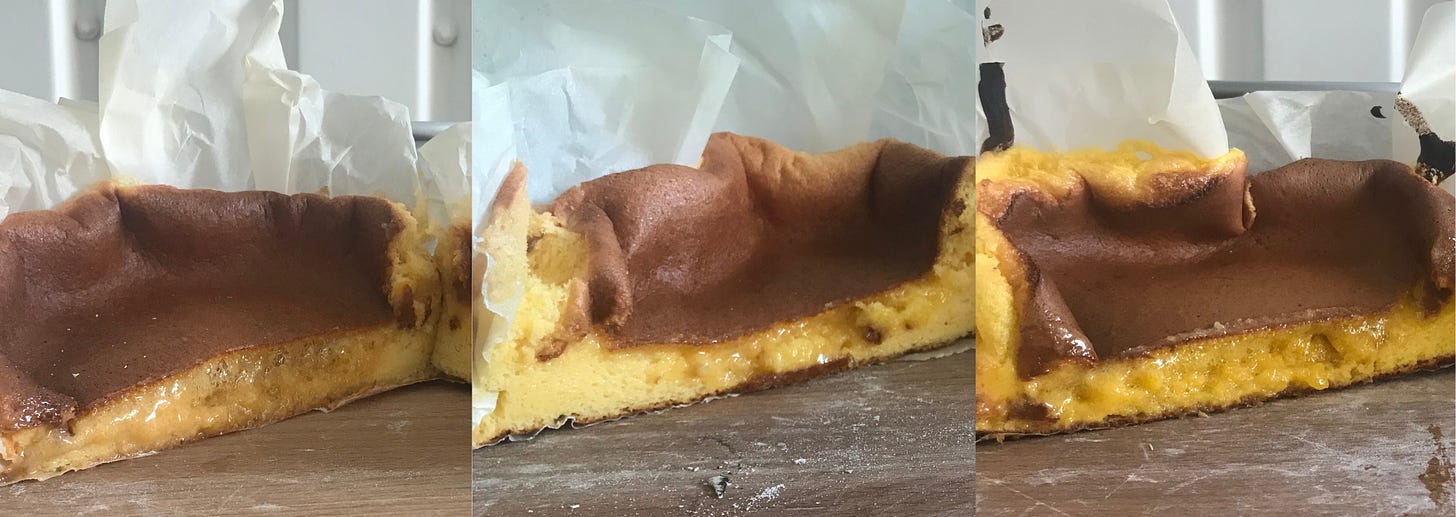
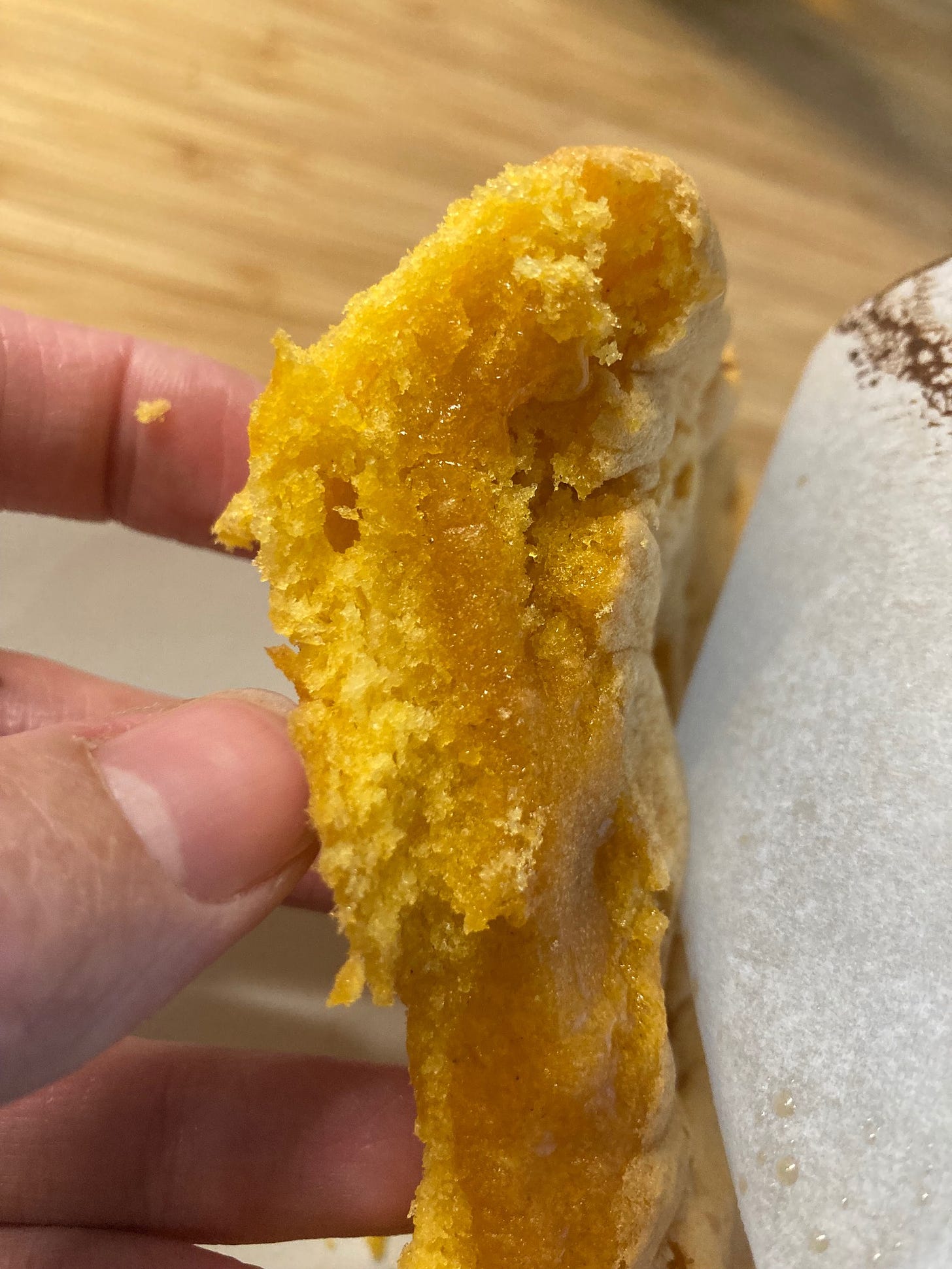
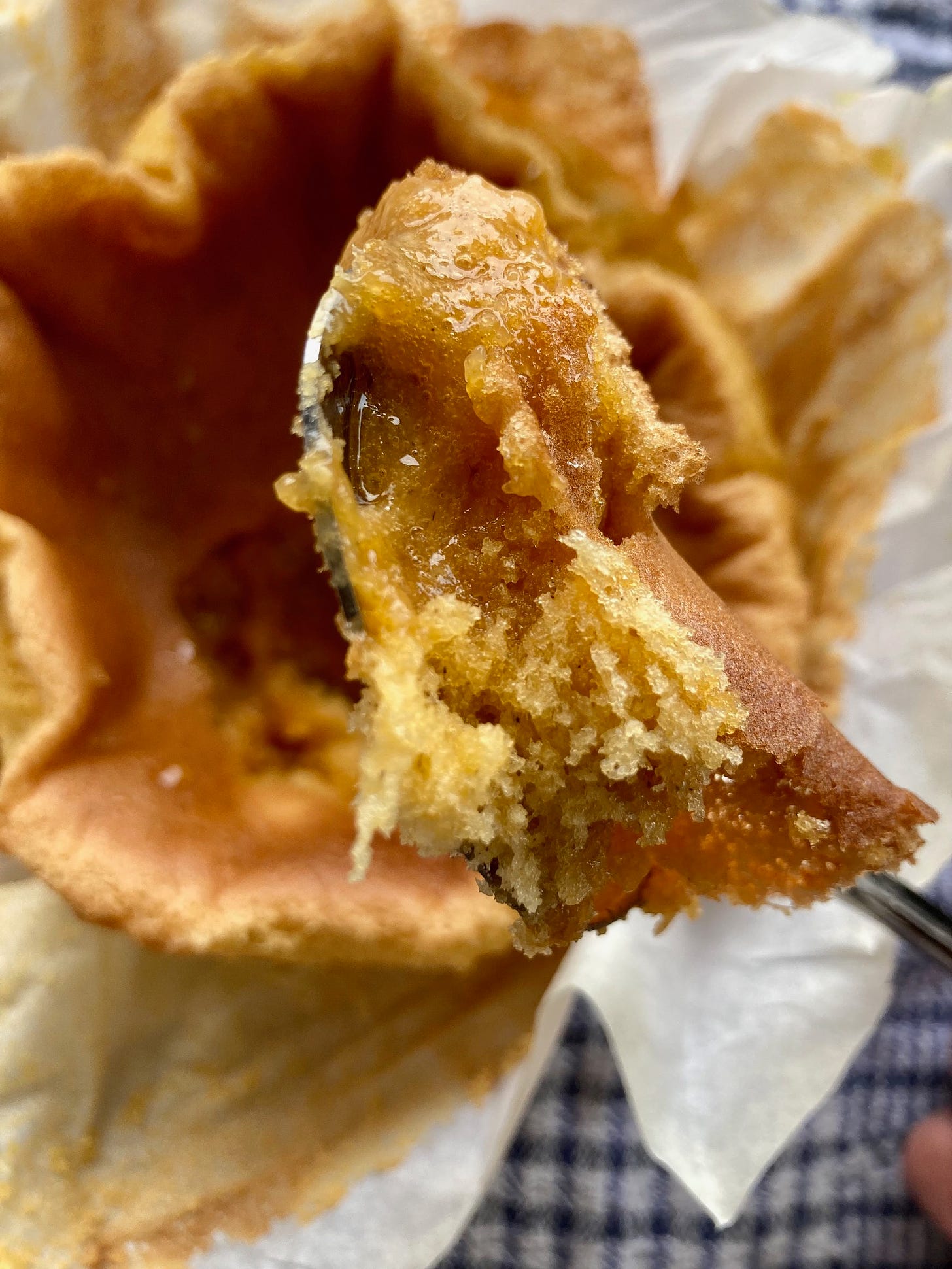
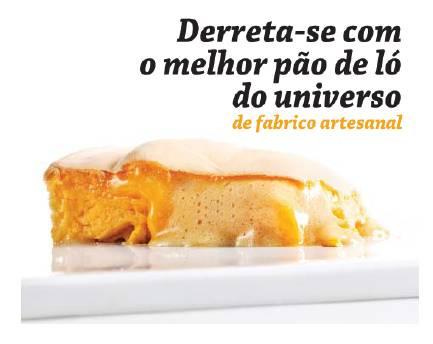
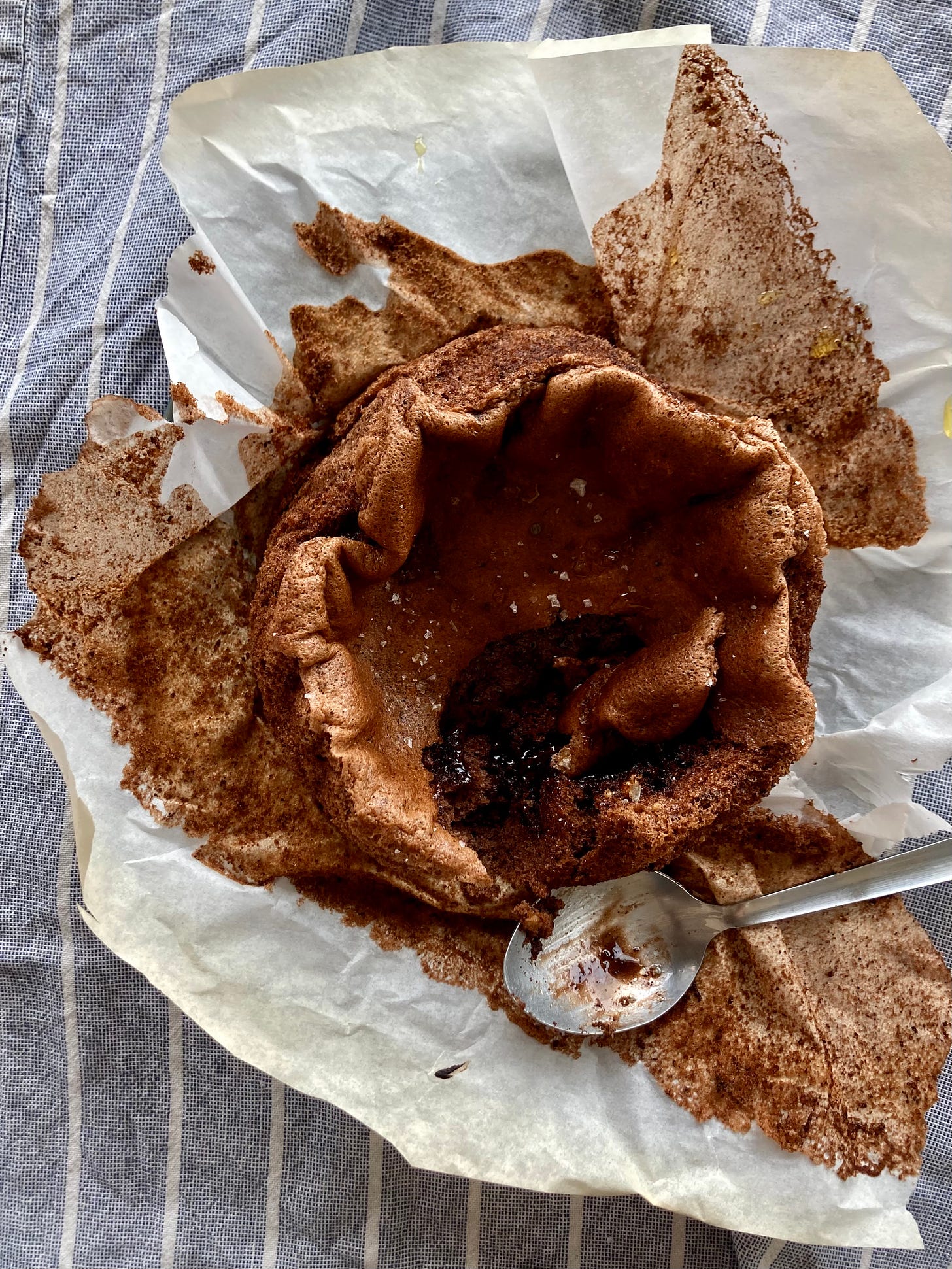
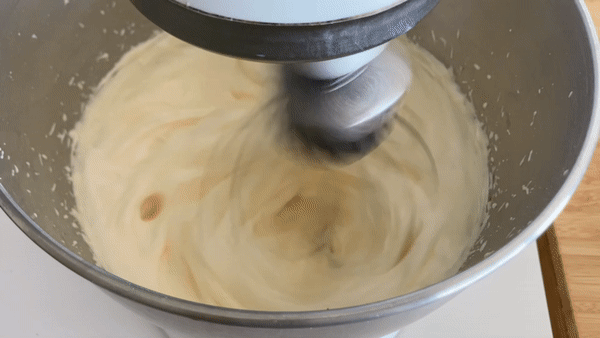
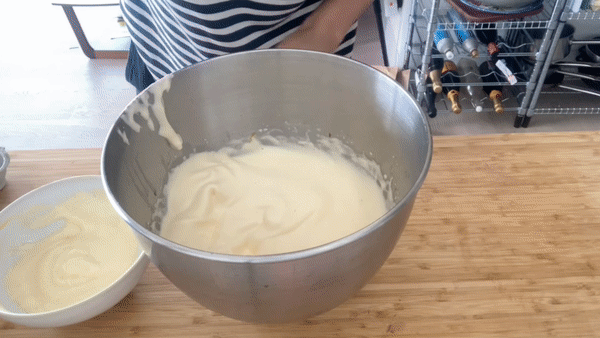
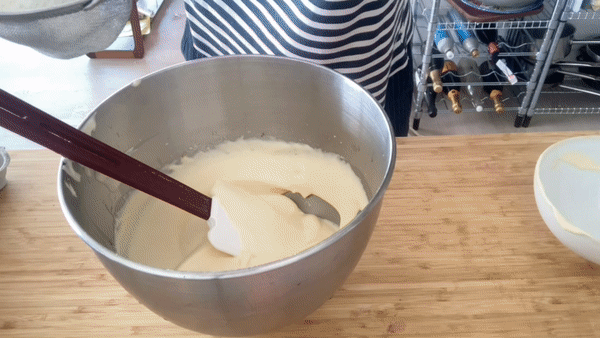
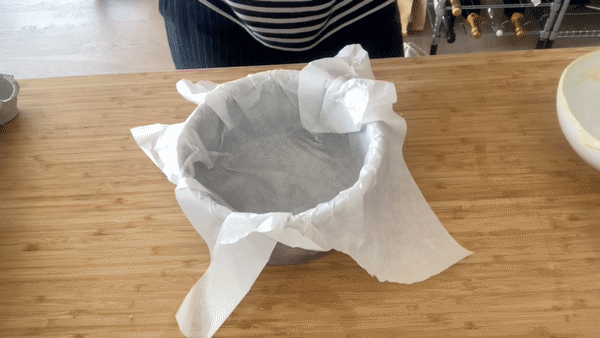
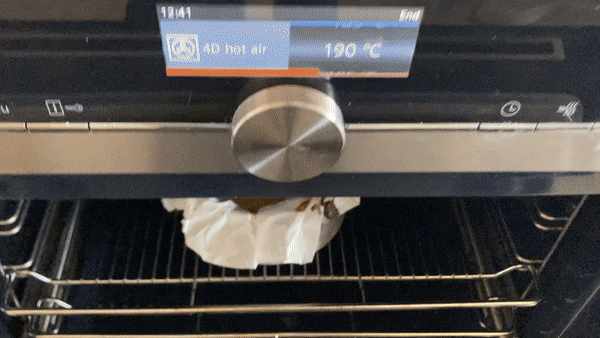
This looks like a dream, maybe a silly question but are we using EVOO or just olive oil in the cake? Thanks 😊😊
How would I double this recipe? Could it go on an 8 or 9 inch pan? Would I increase cook time? Thank you!